Case Study: Analysis of Ted's Biopsychosocial and Spiritual Factors
VerifiedAdded on 2022/07/29
|11
|3056
|52
Case Study
AI Summary
This case study examines Ted's complex health issues, including colorectal cancer, diabetes, and cardiovascular disease, considering biological, psychological, and spiritual factors. It prioritizes his health problems, highlighting the severity of each condition and their associated risk factors. The assignment details appropriate nursing interventions, such as physical exercises, dietary changes, educational programs, and pharmacological treatments, including insulin therapy and analgesics. It emphasizes the importance of cognitive therapy to manage stress and improve Ted's overall health outcomes. The study provides a comprehensive overview of Ted's condition and potential treatment strategies, making it a valuable resource for healthcare professionals and students alike.

Running Head: CASE STUDY 1
Ted’s Case Study
Name of Student
Name of Professor
Institution Affliation
Date
Ted’s Case Study
Name of Student
Name of Professor
Institution Affliation
Date
Paraphrase This Document
Need a fresh take? Get an instant paraphrase of this document with our AI Paraphraser
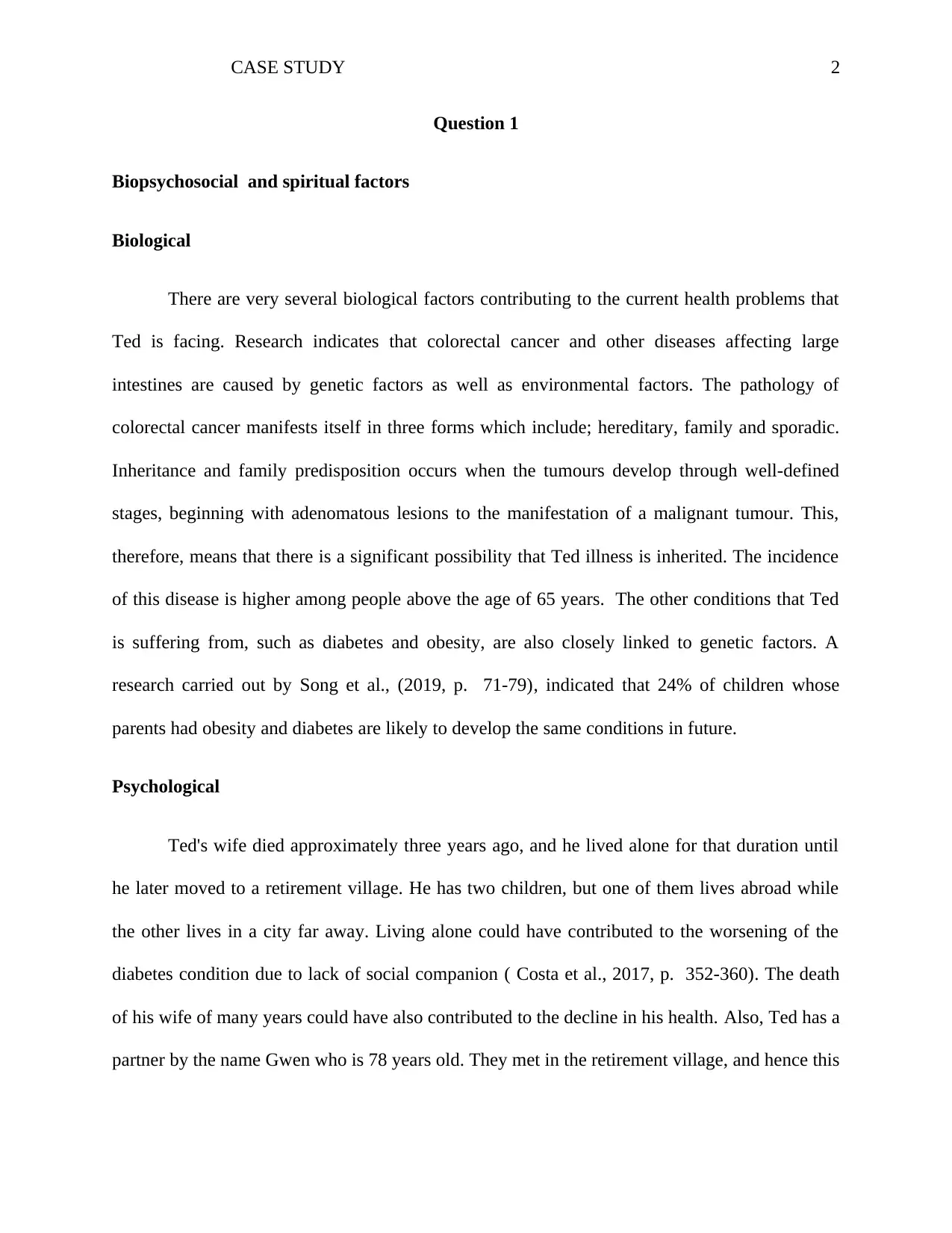
CASE STUDY 2
Question 1
Biopsychosocial and spiritual factors
Biological
There are very several biological factors contributing to the current health problems that
Ted is facing. Research indicates that colorectal cancer and other diseases affecting large
intestines are caused by genetic factors as well as environmental factors. The pathology of
colorectal cancer manifests itself in three forms which include; hereditary, family and sporadic.
Inheritance and family predisposition occurs when the tumours develop through well-defined
stages, beginning with adenomatous lesions to the manifestation of a malignant tumour. This,
therefore, means that there is a significant possibility that Ted illness is inherited. The incidence
of this disease is higher among people above the age of 65 years. The other conditions that Ted
is suffering from, such as diabetes and obesity, are also closely linked to genetic factors. A
research carried out by Song et al., (2019, p. 71-79), indicated that 24% of children whose
parents had obesity and diabetes are likely to develop the same conditions in future.
Psychological
Ted's wife died approximately three years ago, and he lived alone for that duration until
he later moved to a retirement village. He has two children, but one of them lives abroad while
the other lives in a city far away. Living alone could have contributed to the worsening of the
diabetes condition due to lack of social companion ( Costa et al., 2017, p. 352-360). The death
of his wife of many years could have also contributed to the decline in his health. Also, Ted has a
partner by the name Gwen who is 78 years old. They met in the retirement village, and hence this
Question 1
Biopsychosocial and spiritual factors
Biological
There are very several biological factors contributing to the current health problems that
Ted is facing. Research indicates that colorectal cancer and other diseases affecting large
intestines are caused by genetic factors as well as environmental factors. The pathology of
colorectal cancer manifests itself in three forms which include; hereditary, family and sporadic.
Inheritance and family predisposition occurs when the tumours develop through well-defined
stages, beginning with adenomatous lesions to the manifestation of a malignant tumour. This,
therefore, means that there is a significant possibility that Ted illness is inherited. The incidence
of this disease is higher among people above the age of 65 years. The other conditions that Ted
is suffering from, such as diabetes and obesity, are also closely linked to genetic factors. A
research carried out by Song et al., (2019, p. 71-79), indicated that 24% of children whose
parents had obesity and diabetes are likely to develop the same conditions in future.
Psychological
Ted's wife died approximately three years ago, and he lived alone for that duration until
he later moved to a retirement village. He has two children, but one of them lives abroad while
the other lives in a city far away. Living alone could have contributed to the worsening of the
diabetes condition due to lack of social companion ( Costa et al., 2017, p. 352-360). The death
of his wife of many years could have also contributed to the decline in his health. Also, Ted has a
partner by the name Gwen who is 78 years old. They met in the retirement village, and hence this
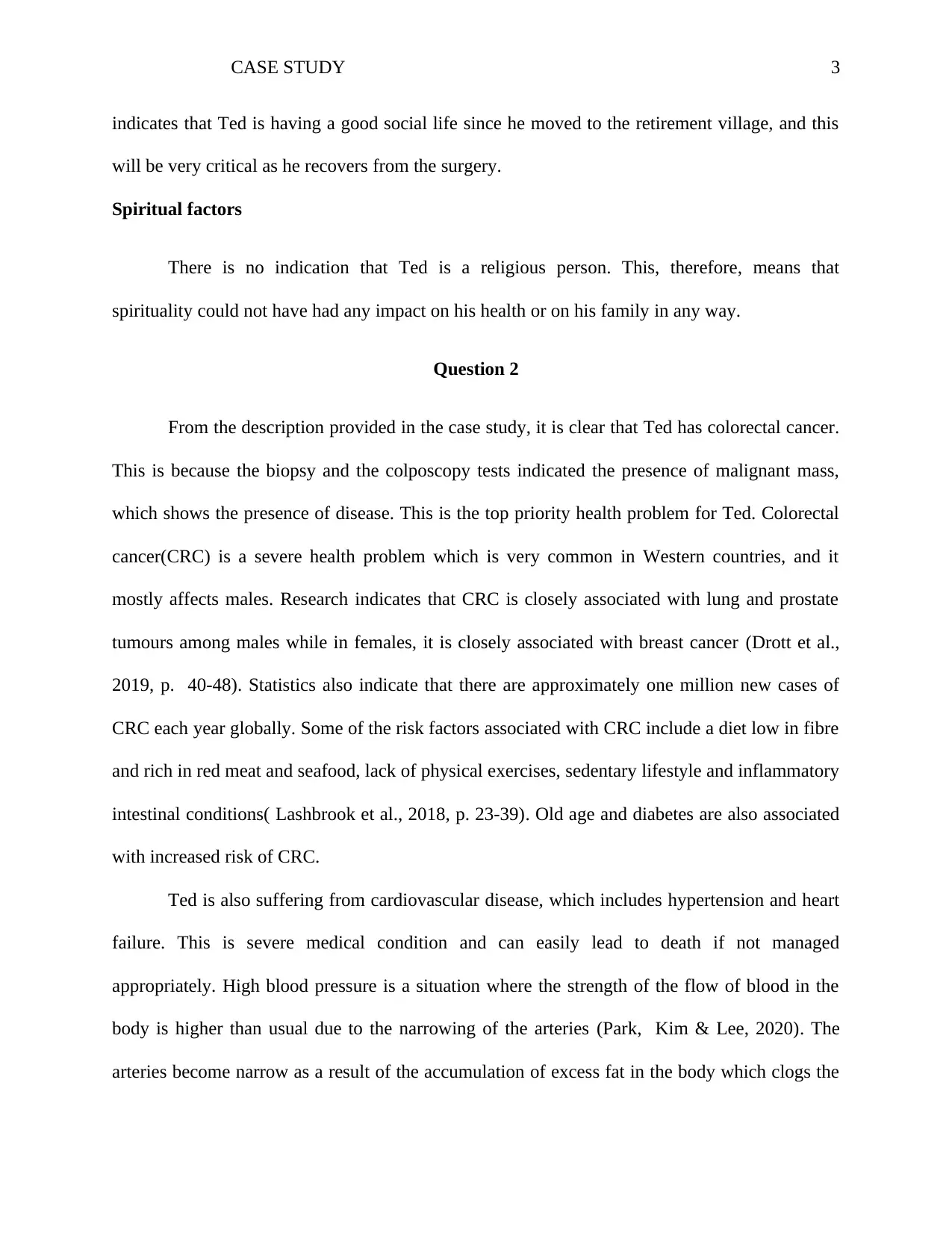
CASE STUDY 3
indicates that Ted is having a good social life since he moved to the retirement village, and this
will be very critical as he recovers from the surgery.
Spiritual factors
There is no indication that Ted is a religious person. This, therefore, means that
spirituality could not have had any impact on his health or on his family in any way.
Question 2
From the description provided in the case study, it is clear that Ted has colorectal cancer.
This is because the biopsy and the colposcopy tests indicated the presence of malignant mass,
which shows the presence of disease. This is the top priority health problem for Ted. Colorectal
cancer(CRC) is a severe health problem which is very common in Western countries, and it
mostly affects males. Research indicates that CRC is closely associated with lung and prostate
tumours among males while in females, it is closely associated with breast cancer (Drott et al.,
2019, p. 40-48). Statistics also indicate that there are approximately one million new cases of
CRC each year globally. Some of the risk factors associated with CRC include a diet low in fibre
and rich in red meat and seafood, lack of physical exercises, sedentary lifestyle and inflammatory
intestinal conditions( Lashbrook et al., 2018, p. 23-39). Old age and diabetes are also associated
with increased risk of CRC.
Ted is also suffering from cardiovascular disease, which includes hypertension and heart
failure. This is severe medical condition and can easily lead to death if not managed
appropriately. High blood pressure is a situation where the strength of the flow of blood in the
body is higher than usual due to the narrowing of the arteries (Park, Kim & Lee, 2020). The
arteries become narrow as a result of the accumulation of excess fat in the body which clogs the
indicates that Ted is having a good social life since he moved to the retirement village, and this
will be very critical as he recovers from the surgery.
Spiritual factors
There is no indication that Ted is a religious person. This, therefore, means that
spirituality could not have had any impact on his health or on his family in any way.
Question 2
From the description provided in the case study, it is clear that Ted has colorectal cancer.
This is because the biopsy and the colposcopy tests indicated the presence of malignant mass,
which shows the presence of disease. This is the top priority health problem for Ted. Colorectal
cancer(CRC) is a severe health problem which is very common in Western countries, and it
mostly affects males. Research indicates that CRC is closely associated with lung and prostate
tumours among males while in females, it is closely associated with breast cancer (Drott et al.,
2019, p. 40-48). Statistics also indicate that there are approximately one million new cases of
CRC each year globally. Some of the risk factors associated with CRC include a diet low in fibre
and rich in red meat and seafood, lack of physical exercises, sedentary lifestyle and inflammatory
intestinal conditions( Lashbrook et al., 2018, p. 23-39). Old age and diabetes are also associated
with increased risk of CRC.
Ted is also suffering from cardiovascular disease, which includes hypertension and heart
failure. This is severe medical condition and can easily lead to death if not managed
appropriately. High blood pressure is a situation where the strength of the flow of blood in the
body is higher than usual due to the narrowing of the arteries (Park, Kim & Lee, 2020). The
arteries become narrow as a result of the accumulation of excess fat in the body which clogs the
⊘ This is a preview!⊘
Do you want full access?
Subscribe today to unlock all pages.

Trusted by 1+ million students worldwide
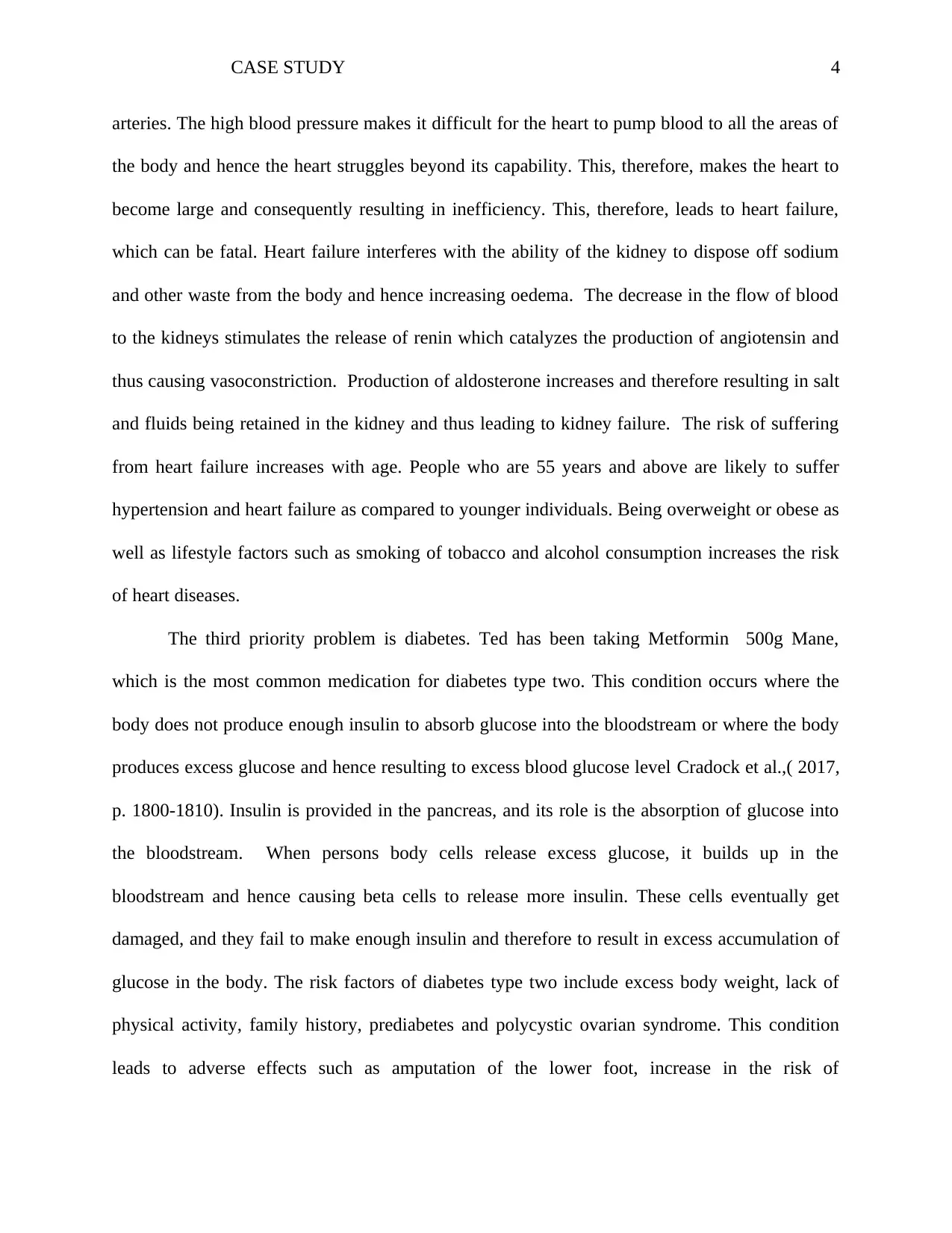
CASE STUDY 4
arteries. The high blood pressure makes it difficult for the heart to pump blood to all the areas of
the body and hence the heart struggles beyond its capability. This, therefore, makes the heart to
become large and consequently resulting in inefficiency. This, therefore, leads to heart failure,
which can be fatal. Heart failure interferes with the ability of the kidney to dispose off sodium
and other waste from the body and hence increasing oedema. The decrease in the flow of blood
to the kidneys stimulates the release of renin which catalyzes the production of angiotensin and
thus causing vasoconstriction. Production of aldosterone increases and therefore resulting in salt
and fluids being retained in the kidney and thus leading to kidney failure. The risk of suffering
from heart failure increases with age. People who are 55 years and above are likely to suffer
hypertension and heart failure as compared to younger individuals. Being overweight or obese as
well as lifestyle factors such as smoking of tobacco and alcohol consumption increases the risk
of heart diseases.
The third priority problem is diabetes. Ted has been taking Metformin 500g Mane,
which is the most common medication for diabetes type two. This condition occurs where the
body does not produce enough insulin to absorb glucose into the bloodstream or where the body
produces excess glucose and hence resulting to excess blood glucose level Cradock et al.,( 2017,
p. 1800-1810). Insulin is provided in the pancreas, and its role is the absorption of glucose into
the bloodstream. When persons body cells release excess glucose, it builds up in the
bloodstream and hence causing beta cells to release more insulin. These cells eventually get
damaged, and they fail to make enough insulin and therefore to result in excess accumulation of
glucose in the body. The risk factors of diabetes type two include excess body weight, lack of
physical activity, family history, prediabetes and polycystic ovarian syndrome. This condition
leads to adverse effects such as amputation of the lower foot, increase in the risk of
arteries. The high blood pressure makes it difficult for the heart to pump blood to all the areas of
the body and hence the heart struggles beyond its capability. This, therefore, makes the heart to
become large and consequently resulting in inefficiency. This, therefore, leads to heart failure,
which can be fatal. Heart failure interferes with the ability of the kidney to dispose off sodium
and other waste from the body and hence increasing oedema. The decrease in the flow of blood
to the kidneys stimulates the release of renin which catalyzes the production of angiotensin and
thus causing vasoconstriction. Production of aldosterone increases and therefore resulting in salt
and fluids being retained in the kidney and thus leading to kidney failure. The risk of suffering
from heart failure increases with age. People who are 55 years and above are likely to suffer
hypertension and heart failure as compared to younger individuals. Being overweight or obese as
well as lifestyle factors such as smoking of tobacco and alcohol consumption increases the risk
of heart diseases.
The third priority problem is diabetes. Ted has been taking Metformin 500g Mane,
which is the most common medication for diabetes type two. This condition occurs where the
body does not produce enough insulin to absorb glucose into the bloodstream or where the body
produces excess glucose and hence resulting to excess blood glucose level Cradock et al.,( 2017,
p. 1800-1810). Insulin is provided in the pancreas, and its role is the absorption of glucose into
the bloodstream. When persons body cells release excess glucose, it builds up in the
bloodstream and hence causing beta cells to release more insulin. These cells eventually get
damaged, and they fail to make enough insulin and therefore to result in excess accumulation of
glucose in the body. The risk factors of diabetes type two include excess body weight, lack of
physical activity, family history, prediabetes and polycystic ovarian syndrome. This condition
leads to adverse effects such as amputation of the lower foot, increase in the risk of
Paraphrase This Document
Need a fresh take? Get an instant paraphrase of this document with our AI Paraphraser
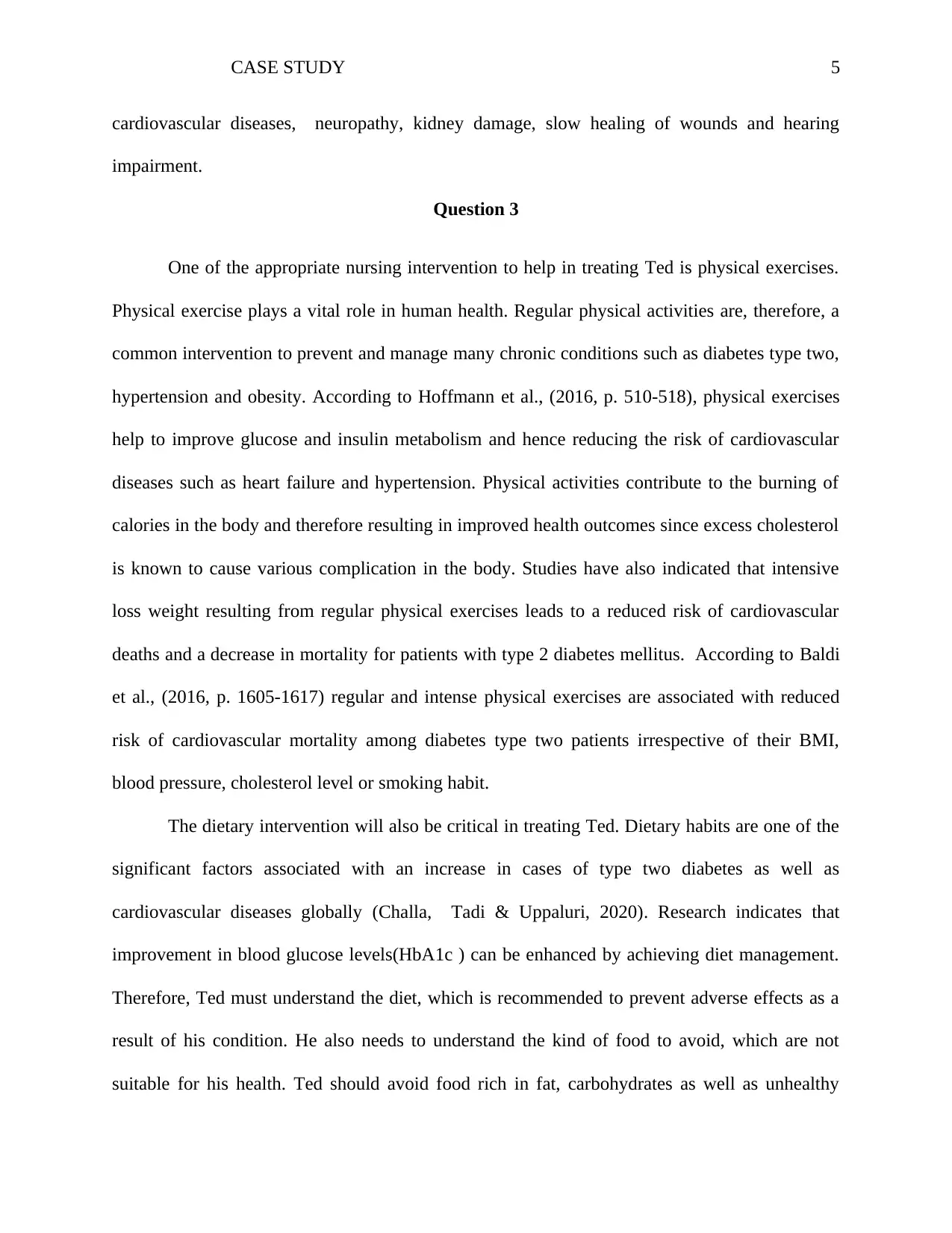
CASE STUDY 5
cardiovascular diseases, neuropathy, kidney damage, slow healing of wounds and hearing
impairment.
Question 3
One of the appropriate nursing intervention to help in treating Ted is physical exercises.
Physical exercise plays a vital role in human health. Regular physical activities are, therefore, a
common intervention to prevent and manage many chronic conditions such as diabetes type two,
hypertension and obesity. According to Hoffmann et al., (2016, p. 510-518), physical exercises
help to improve glucose and insulin metabolism and hence reducing the risk of cardiovascular
diseases such as heart failure and hypertension. Physical activities contribute to the burning of
calories in the body and therefore resulting in improved health outcomes since excess cholesterol
is known to cause various complication in the body. Studies have also indicated that intensive
loss weight resulting from regular physical exercises leads to a reduced risk of cardiovascular
deaths and a decrease in mortality for patients with type 2 diabetes mellitus. According to Baldi
et al., (2016, p. 1605-1617) regular and intense physical exercises are associated with reduced
risk of cardiovascular mortality among diabetes type two patients irrespective of their BMI,
blood pressure, cholesterol level or smoking habit.
The dietary intervention will also be critical in treating Ted. Dietary habits are one of the
significant factors associated with an increase in cases of type two diabetes as well as
cardiovascular diseases globally (Challa, Tadi & Uppaluri, 2020). Research indicates that
improvement in blood glucose levels(HbA1c ) can be enhanced by achieving diet management.
Therefore, Ted must understand the diet, which is recommended to prevent adverse effects as a
result of his condition. He also needs to understand the kind of food to avoid, which are not
suitable for his health. Ted should avoid food rich in fat, carbohydrates as well as unhealthy
cardiovascular diseases, neuropathy, kidney damage, slow healing of wounds and hearing
impairment.
Question 3
One of the appropriate nursing intervention to help in treating Ted is physical exercises.
Physical exercise plays a vital role in human health. Regular physical activities are, therefore, a
common intervention to prevent and manage many chronic conditions such as diabetes type two,
hypertension and obesity. According to Hoffmann et al., (2016, p. 510-518), physical exercises
help to improve glucose and insulin metabolism and hence reducing the risk of cardiovascular
diseases such as heart failure and hypertension. Physical activities contribute to the burning of
calories in the body and therefore resulting in improved health outcomes since excess cholesterol
is known to cause various complication in the body. Studies have also indicated that intensive
loss weight resulting from regular physical exercises leads to a reduced risk of cardiovascular
deaths and a decrease in mortality for patients with type 2 diabetes mellitus. According to Baldi
et al., (2016, p. 1605-1617) regular and intense physical exercises are associated with reduced
risk of cardiovascular mortality among diabetes type two patients irrespective of their BMI,
blood pressure, cholesterol level or smoking habit.
The dietary intervention will also be critical in treating Ted. Dietary habits are one of the
significant factors associated with an increase in cases of type two diabetes as well as
cardiovascular diseases globally (Challa, Tadi & Uppaluri, 2020). Research indicates that
improvement in blood glucose levels(HbA1c ) can be enhanced by achieving diet management.
Therefore, Ted must understand the diet, which is recommended to prevent adverse effects as a
result of his condition. He also needs to understand the kind of food to avoid, which are not
suitable for his health. Ted should avoid food rich in fat, carbohydrates as well as unhealthy
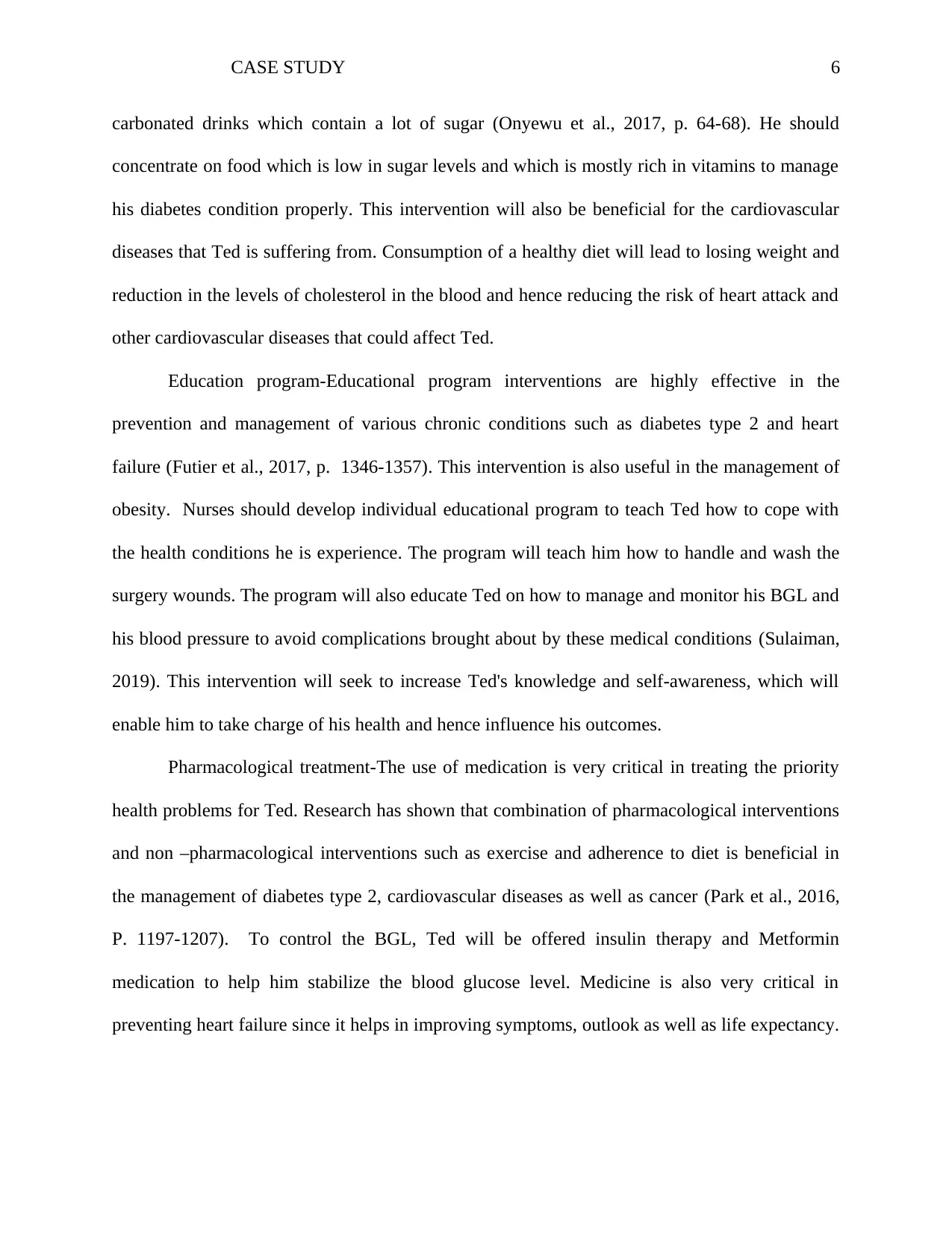
CASE STUDY 6
carbonated drinks which contain a lot of sugar (Onyewu et al., 2017, p. 64-68). He should
concentrate on food which is low in sugar levels and which is mostly rich in vitamins to manage
his diabetes condition properly. This intervention will also be beneficial for the cardiovascular
diseases that Ted is suffering from. Consumption of a healthy diet will lead to losing weight and
reduction in the levels of cholesterol in the blood and hence reducing the risk of heart attack and
other cardiovascular diseases that could affect Ted.
Education program-Educational program interventions are highly effective in the
prevention and management of various chronic conditions such as diabetes type 2 and heart
failure (Futier et al., 2017, p. 1346-1357). This intervention is also useful in the management of
obesity. Nurses should develop individual educational program to teach Ted how to cope with
the health conditions he is experience. The program will teach him how to handle and wash the
surgery wounds. The program will also educate Ted on how to manage and monitor his BGL and
his blood pressure to avoid complications brought about by these medical conditions (Sulaiman,
2019). This intervention will seek to increase Ted's knowledge and self-awareness, which will
enable him to take charge of his health and hence influence his outcomes.
Pharmacological treatment-The use of medication is very critical in treating the priority
health problems for Ted. Research has shown that combination of pharmacological interventions
and non –pharmacological interventions such as exercise and adherence to diet is beneficial in
the management of diabetes type 2, cardiovascular diseases as well as cancer (Park et al., 2016,
P. 1197-1207). To control the BGL, Ted will be offered insulin therapy and Metformin
medication to help him stabilize the blood glucose level. Medicine is also very critical in
preventing heart failure since it helps in improving symptoms, outlook as well as life expectancy.
carbonated drinks which contain a lot of sugar (Onyewu et al., 2017, p. 64-68). He should
concentrate on food which is low in sugar levels and which is mostly rich in vitamins to manage
his diabetes condition properly. This intervention will also be beneficial for the cardiovascular
diseases that Ted is suffering from. Consumption of a healthy diet will lead to losing weight and
reduction in the levels of cholesterol in the blood and hence reducing the risk of heart attack and
other cardiovascular diseases that could affect Ted.
Education program-Educational program interventions are highly effective in the
prevention and management of various chronic conditions such as diabetes type 2 and heart
failure (Futier et al., 2017, p. 1346-1357). This intervention is also useful in the management of
obesity. Nurses should develop individual educational program to teach Ted how to cope with
the health conditions he is experience. The program will teach him how to handle and wash the
surgery wounds. The program will also educate Ted on how to manage and monitor his BGL and
his blood pressure to avoid complications brought about by these medical conditions (Sulaiman,
2019). This intervention will seek to increase Ted's knowledge and self-awareness, which will
enable him to take charge of his health and hence influence his outcomes.
Pharmacological treatment-The use of medication is very critical in treating the priority
health problems for Ted. Research has shown that combination of pharmacological interventions
and non –pharmacological interventions such as exercise and adherence to diet is beneficial in
the management of diabetes type 2, cardiovascular diseases as well as cancer (Park et al., 2016,
P. 1197-1207). To control the BGL, Ted will be offered insulin therapy and Metformin
medication to help him stabilize the blood glucose level. Medicine is also very critical in
preventing heart failure since it helps in improving symptoms, outlook as well as life expectancy.
⊘ This is a preview!⊘
Do you want full access?
Subscribe today to unlock all pages.

Trusted by 1+ million students worldwide
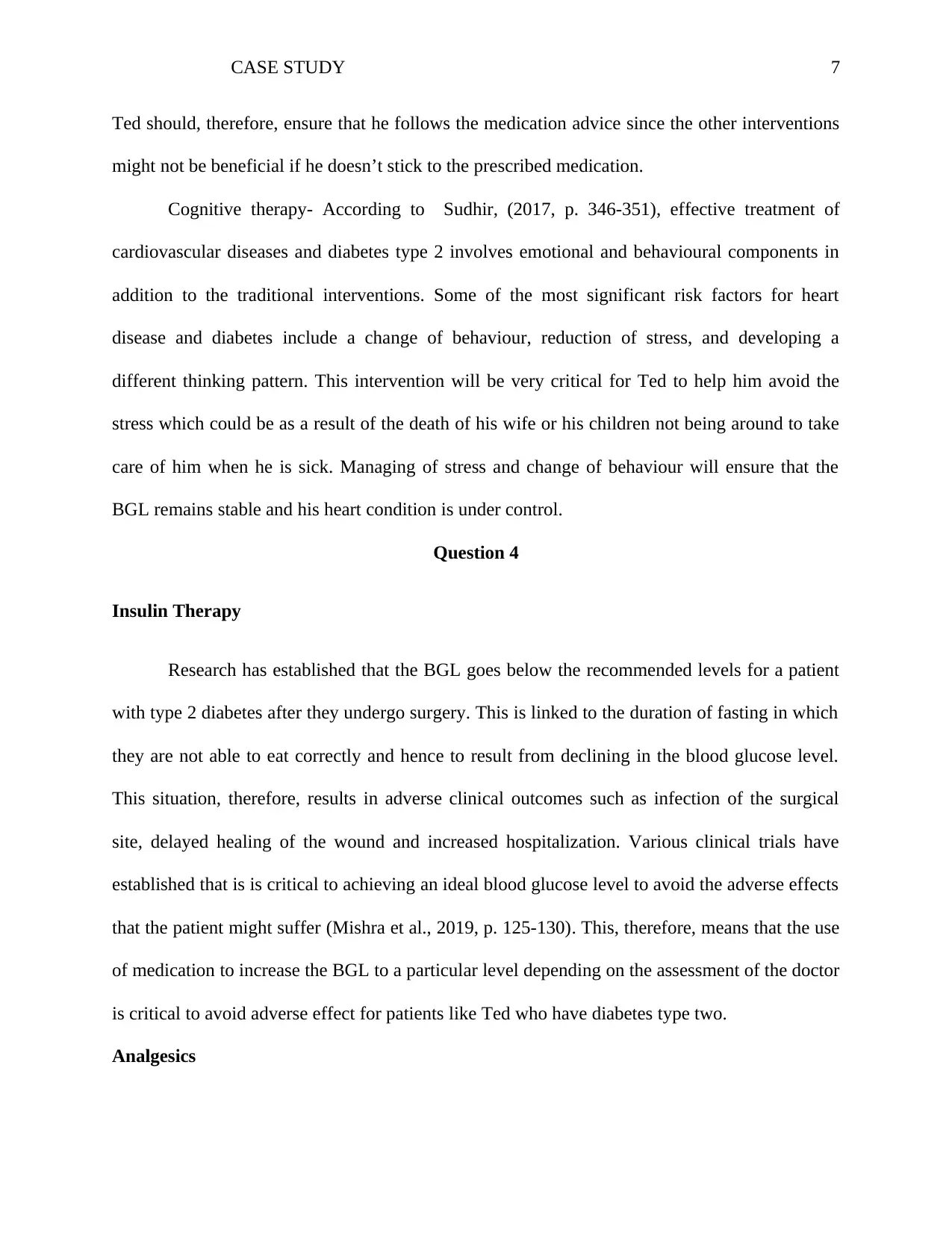
CASE STUDY 7
Ted should, therefore, ensure that he follows the medication advice since the other interventions
might not be beneficial if he doesn’t stick to the prescribed medication.
Cognitive therapy- According to Sudhir, (2017, p. 346-351), effective treatment of
cardiovascular diseases and diabetes type 2 involves emotional and behavioural components in
addition to the traditional interventions. Some of the most significant risk factors for heart
disease and diabetes include a change of behaviour, reduction of stress, and developing a
different thinking pattern. This intervention will be very critical for Ted to help him avoid the
stress which could be as a result of the death of his wife or his children not being around to take
care of him when he is sick. Managing of stress and change of behaviour will ensure that the
BGL remains stable and his heart condition is under control.
Question 4
Insulin Therapy
Research has established that the BGL goes below the recommended levels for a patient
with type 2 diabetes after they undergo surgery. This is linked to the duration of fasting in which
they are not able to eat correctly and hence to result from declining in the blood glucose level.
This situation, therefore, results in adverse clinical outcomes such as infection of the surgical
site, delayed healing of the wound and increased hospitalization. Various clinical trials have
established that is is critical to achieving an ideal blood glucose level to avoid the adverse effects
that the patient might suffer (Mishra et al., 2019, p. 125-130). This, therefore, means that the use
of medication to increase the BGL to a particular level depending on the assessment of the doctor
is critical to avoid adverse effect for patients like Ted who have diabetes type two.
Analgesics
Ted should, therefore, ensure that he follows the medication advice since the other interventions
might not be beneficial if he doesn’t stick to the prescribed medication.
Cognitive therapy- According to Sudhir, (2017, p. 346-351), effective treatment of
cardiovascular diseases and diabetes type 2 involves emotional and behavioural components in
addition to the traditional interventions. Some of the most significant risk factors for heart
disease and diabetes include a change of behaviour, reduction of stress, and developing a
different thinking pattern. This intervention will be very critical for Ted to help him avoid the
stress which could be as a result of the death of his wife or his children not being around to take
care of him when he is sick. Managing of stress and change of behaviour will ensure that the
BGL remains stable and his heart condition is under control.
Question 4
Insulin Therapy
Research has established that the BGL goes below the recommended levels for a patient
with type 2 diabetes after they undergo surgery. This is linked to the duration of fasting in which
they are not able to eat correctly and hence to result from declining in the blood glucose level.
This situation, therefore, results in adverse clinical outcomes such as infection of the surgical
site, delayed healing of the wound and increased hospitalization. Various clinical trials have
established that is is critical to achieving an ideal blood glucose level to avoid the adverse effects
that the patient might suffer (Mishra et al., 2019, p. 125-130). This, therefore, means that the use
of medication to increase the BGL to a particular level depending on the assessment of the doctor
is critical to avoid adverse effect for patients like Ted who have diabetes type two.
Analgesics
Paraphrase This Document
Need a fresh take? Get an instant paraphrase of this document with our AI Paraphraser
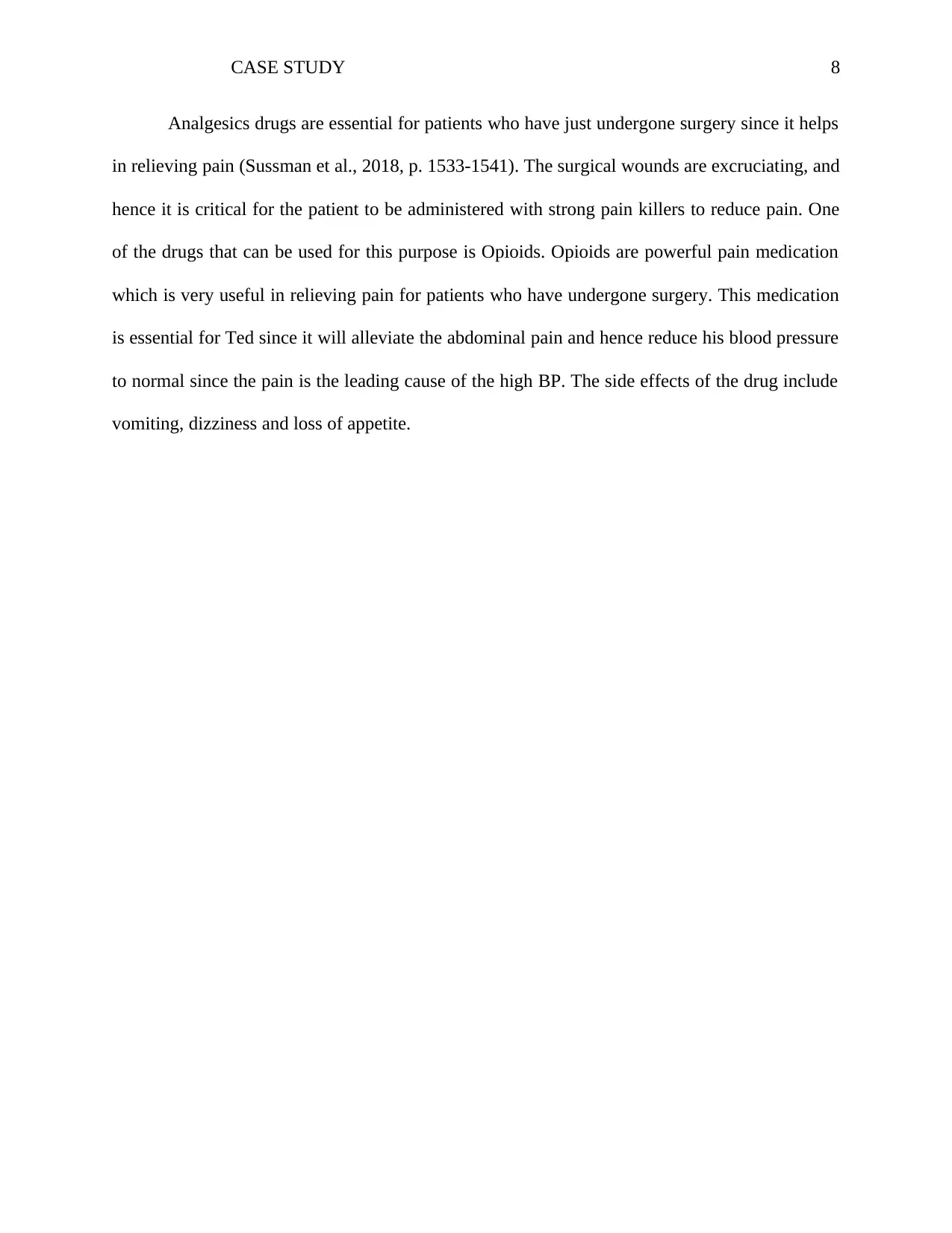
CASE STUDY 8
Analgesics drugs are essential for patients who have just undergone surgery since it helps
in relieving pain (Sussman et al., 2018, p. 1533-1541). The surgical wounds are excruciating, and
hence it is critical for the patient to be administered with strong pain killers to reduce pain. One
of the drugs that can be used for this purpose is Opioids. Opioids are powerful pain medication
which is very useful in relieving pain for patients who have undergone surgery. This medication
is essential for Ted since it will alleviate the abdominal pain and hence reduce his blood pressure
to normal since the pain is the leading cause of the high BP. The side effects of the drug include
vomiting, dizziness and loss of appetite.
Analgesics drugs are essential for patients who have just undergone surgery since it helps
in relieving pain (Sussman et al., 2018, p. 1533-1541). The surgical wounds are excruciating, and
hence it is critical for the patient to be administered with strong pain killers to reduce pain. One
of the drugs that can be used for this purpose is Opioids. Opioids are powerful pain medication
which is very useful in relieving pain for patients who have undergone surgery. This medication
is essential for Ted since it will alleviate the abdominal pain and hence reduce his blood pressure
to normal since the pain is the leading cause of the high BP. The side effects of the drug include
vomiting, dizziness and loss of appetite.
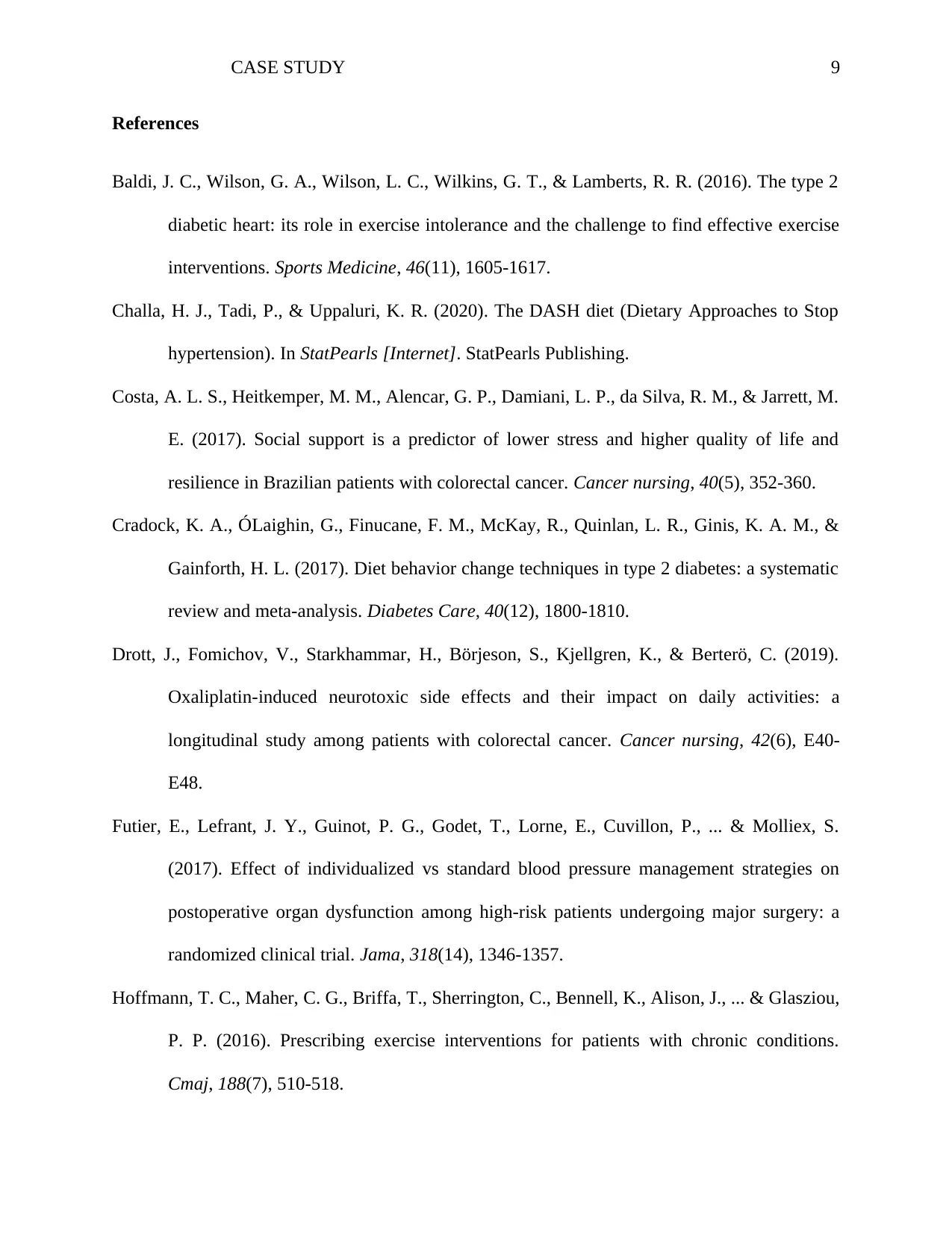
CASE STUDY 9
References
Baldi, J. C., Wilson, G. A., Wilson, L. C., Wilkins, G. T., & Lamberts, R. R. (2016). The type 2
diabetic heart: its role in exercise intolerance and the challenge to find effective exercise
interventions. Sports Medicine, 46(11), 1605-1617.
Challa, H. J., Tadi, P., & Uppaluri, K. R. (2020). The DASH diet (Dietary Approaches to Stop
hypertension). In StatPearls [Internet]. StatPearls Publishing.
Costa, A. L. S., Heitkemper, M. M., Alencar, G. P., Damiani, L. P., da Silva, R. M., & Jarrett, M.
E. (2017). Social support is a predictor of lower stress and higher quality of life and
resilience in Brazilian patients with colorectal cancer. Cancer nursing, 40(5), 352-360.
Cradock, K. A., ÓLaighin, G., Finucane, F. M., McKay, R., Quinlan, L. R., Ginis, K. A. M., &
Gainforth, H. L. (2017). Diet behavior change techniques in type 2 diabetes: a systematic
review and meta-analysis. Diabetes Care, 40(12), 1800-1810.
Drott, J., Fomichov, V., Starkhammar, H., Börjeson, S., Kjellgren, K., & Berterö, C. (2019).
Oxaliplatin-induced neurotoxic side effects and their impact on daily activities: a
longitudinal study among patients with colorectal cancer. Cancer nursing, 42(6), E40-
E48.
Futier, E., Lefrant, J. Y., Guinot, P. G., Godet, T., Lorne, E., Cuvillon, P., ... & Molliex, S.
(2017). Effect of individualized vs standard blood pressure management strategies on
postoperative organ dysfunction among high-risk patients undergoing major surgery: a
randomized clinical trial. Jama, 318(14), 1346-1357.
Hoffmann, T. C., Maher, C. G., Briffa, T., Sherrington, C., Bennell, K., Alison, J., ... & Glasziou,
P. P. (2016). Prescribing exercise interventions for patients with chronic conditions.
Cmaj, 188(7), 510-518.
References
Baldi, J. C., Wilson, G. A., Wilson, L. C., Wilkins, G. T., & Lamberts, R. R. (2016). The type 2
diabetic heart: its role in exercise intolerance and the challenge to find effective exercise
interventions. Sports Medicine, 46(11), 1605-1617.
Challa, H. J., Tadi, P., & Uppaluri, K. R. (2020). The DASH diet (Dietary Approaches to Stop
hypertension). In StatPearls [Internet]. StatPearls Publishing.
Costa, A. L. S., Heitkemper, M. M., Alencar, G. P., Damiani, L. P., da Silva, R. M., & Jarrett, M.
E. (2017). Social support is a predictor of lower stress and higher quality of life and
resilience in Brazilian patients with colorectal cancer. Cancer nursing, 40(5), 352-360.
Cradock, K. A., ÓLaighin, G., Finucane, F. M., McKay, R., Quinlan, L. R., Ginis, K. A. M., &
Gainforth, H. L. (2017). Diet behavior change techniques in type 2 diabetes: a systematic
review and meta-analysis. Diabetes Care, 40(12), 1800-1810.
Drott, J., Fomichov, V., Starkhammar, H., Börjeson, S., Kjellgren, K., & Berterö, C. (2019).
Oxaliplatin-induced neurotoxic side effects and their impact on daily activities: a
longitudinal study among patients with colorectal cancer. Cancer nursing, 42(6), E40-
E48.
Futier, E., Lefrant, J. Y., Guinot, P. G., Godet, T., Lorne, E., Cuvillon, P., ... & Molliex, S.
(2017). Effect of individualized vs standard blood pressure management strategies on
postoperative organ dysfunction among high-risk patients undergoing major surgery: a
randomized clinical trial. Jama, 318(14), 1346-1357.
Hoffmann, T. C., Maher, C. G., Briffa, T., Sherrington, C., Bennell, K., Alison, J., ... & Glasziou,
P. P. (2016). Prescribing exercise interventions for patients with chronic conditions.
Cmaj, 188(7), 510-518.
⊘ This is a preview!⊘
Do you want full access?
Subscribe today to unlock all pages.

Trusted by 1+ million students worldwide
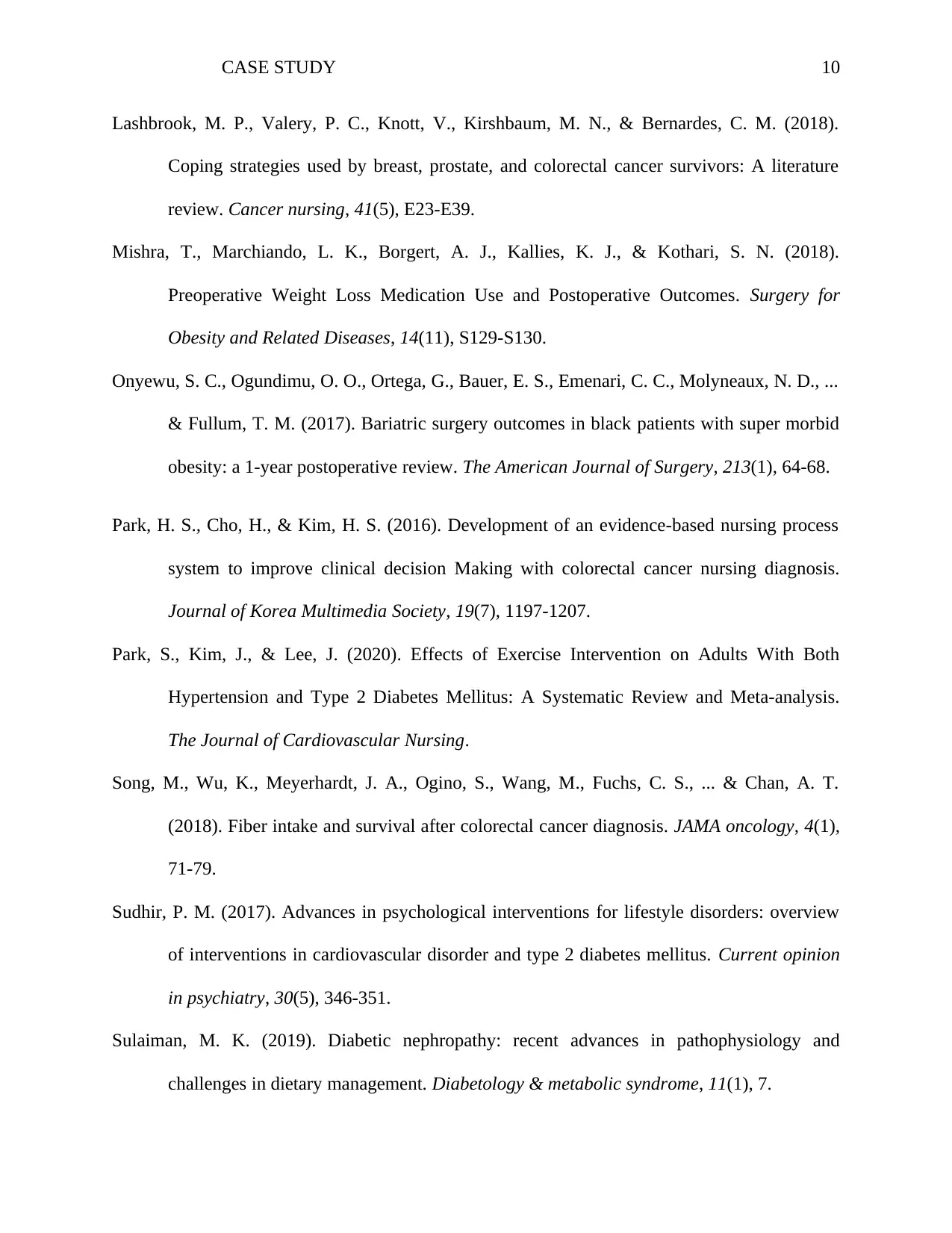
CASE STUDY 10
Lashbrook, M. P., Valery, P. C., Knott, V., Kirshbaum, M. N., & Bernardes, C. M. (2018).
Coping strategies used by breast, prostate, and colorectal cancer survivors: A literature
review. Cancer nursing, 41(5), E23-E39.
Mishra, T., Marchiando, L. K., Borgert, A. J., Kallies, K. J., & Kothari, S. N. (2018).
Preoperative Weight Loss Medication Use and Postoperative Outcomes. Surgery for
Obesity and Related Diseases, 14(11), S129-S130.
Onyewu, S. C., Ogundimu, O. O., Ortega, G., Bauer, E. S., Emenari, C. C., Molyneaux, N. D., ...
& Fullum, T. M. (2017). Bariatric surgery outcomes in black patients with super morbid
obesity: a 1-year postoperative review. The American Journal of Surgery, 213(1), 64-68.
Park, H. S., Cho, H., & Kim, H. S. (2016). Development of an evidence-based nursing process
system to improve clinical decision Making with colorectal cancer nursing diagnosis.
Journal of Korea Multimedia Society, 19(7), 1197-1207.
Park, S., Kim, J., & Lee, J. (2020). Effects of Exercise Intervention on Adults With Both
Hypertension and Type 2 Diabetes Mellitus: A Systematic Review and Meta-analysis.
The Journal of Cardiovascular Nursing.
Song, M., Wu, K., Meyerhardt, J. A., Ogino, S., Wang, M., Fuchs, C. S., ... & Chan, A. T.
(2018). Fiber intake and survival after colorectal cancer diagnosis. JAMA oncology, 4(1),
71-79.
Sudhir, P. M. (2017). Advances in psychological interventions for lifestyle disorders: overview
of interventions in cardiovascular disorder and type 2 diabetes mellitus. Current opinion
in psychiatry, 30(5), 346-351.
Sulaiman, M. K. (2019). Diabetic nephropathy: recent advances in pathophysiology and
challenges in dietary management. Diabetology & metabolic syndrome, 11(1), 7.
Lashbrook, M. P., Valery, P. C., Knott, V., Kirshbaum, M. N., & Bernardes, C. M. (2018).
Coping strategies used by breast, prostate, and colorectal cancer survivors: A literature
review. Cancer nursing, 41(5), E23-E39.
Mishra, T., Marchiando, L. K., Borgert, A. J., Kallies, K. J., & Kothari, S. N. (2018).
Preoperative Weight Loss Medication Use and Postoperative Outcomes. Surgery for
Obesity and Related Diseases, 14(11), S129-S130.
Onyewu, S. C., Ogundimu, O. O., Ortega, G., Bauer, E. S., Emenari, C. C., Molyneaux, N. D., ...
& Fullum, T. M. (2017). Bariatric surgery outcomes in black patients with super morbid
obesity: a 1-year postoperative review. The American Journal of Surgery, 213(1), 64-68.
Park, H. S., Cho, H., & Kim, H. S. (2016). Development of an evidence-based nursing process
system to improve clinical decision Making with colorectal cancer nursing diagnosis.
Journal of Korea Multimedia Society, 19(7), 1197-1207.
Park, S., Kim, J., & Lee, J. (2020). Effects of Exercise Intervention on Adults With Both
Hypertension and Type 2 Diabetes Mellitus: A Systematic Review and Meta-analysis.
The Journal of Cardiovascular Nursing.
Song, M., Wu, K., Meyerhardt, J. A., Ogino, S., Wang, M., Fuchs, C. S., ... & Chan, A. T.
(2018). Fiber intake and survival after colorectal cancer diagnosis. JAMA oncology, 4(1),
71-79.
Sudhir, P. M. (2017). Advances in psychological interventions for lifestyle disorders: overview
of interventions in cardiovascular disorder and type 2 diabetes mellitus. Current opinion
in psychiatry, 30(5), 346-351.
Sulaiman, M. K. (2019). Diabetic nephropathy: recent advances in pathophysiology and
challenges in dietary management. Diabetology & metabolic syndrome, 11(1), 7.
Paraphrase This Document
Need a fresh take? Get an instant paraphrase of this document with our AI Paraphraser

CASE STUDY 11
Sussman, J., Bainbridge, D., Whelan, T. J., Brazil, K., Parpia, S., Wiernikowski, J., ... & Howell,
D. (2018). Evaluation of a specialized oncology nursing supportive care intervention in
newly diagnosed breast and colorectal cancer patients following surgery: a cluster
randomized trial. Supportive Care in Cancer, 26(5), 1533-1541.
Sussman, J., Bainbridge, D., Whelan, T. J., Brazil, K., Parpia, S., Wiernikowski, J., ... & Howell,
D. (2018). Evaluation of a specialized oncology nursing supportive care intervention in
newly diagnosed breast and colorectal cancer patients following surgery: a cluster
randomized trial. Supportive Care in Cancer, 26(5), 1533-1541.
1 out of 11
Related Documents
Your All-in-One AI-Powered Toolkit for Academic Success.
+13062052269
info@desklib.com
Available 24*7 on WhatsApp / Email
![[object Object]](/_next/static/media/star-bottom.7253800d.svg)
Unlock your academic potential
Copyright © 2020–2025 A2Z Services. All Rights Reserved. Developed and managed by ZUCOL.





